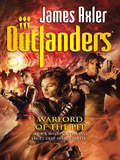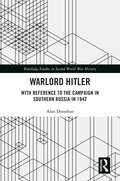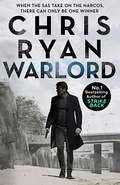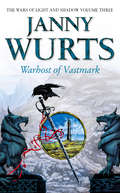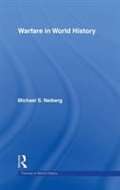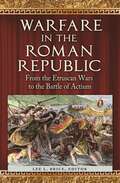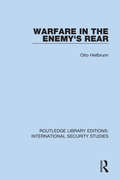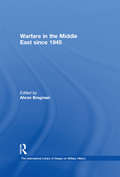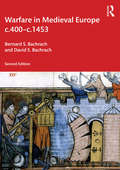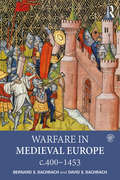- Table View
- List View
Warlord Of The Pit
by James AxlerThe war to pull Earth and humanity back from the iron grip of slavery shifts against an inhuman enemy both calculating and unpredictable. For those with the knowledge and will to reclaim their planet, a blueprint for survival has emerged: to challenge the future, they must reckon with the chilling and immutable past.
Warlord Hitler: With Reference to the Campaign in Southern Russia in 1942 (Routledge Studies in Second World War History)
by Alan DonohueThis book is a study of Adolf Hitler in his role as military commander and strategist from the beginning of the Second World War until the end of 1942, examining in detail the campaign in southern Russia that year. The thesis challenges the post-war narrative of Hitler as a dilettante who was solely responsible for the strategic and operational errors that led to Germany’s defeat in the war. Instead, this research highlights that decisions made by Hitler with respect to such disparate themes as strategy, operations, logistics, intelligence, economics, air and naval power, and coalition warfare were generally sound if viewed from his perspective, even if they were not ultimately successful. It also gives an overview of his own ideas concerning all aspects of military affairs, such as intelligence, command and morale. The careful analysis of Hitler’s decision-making process offers a unique contribution to Second World War scholarship and moves beyond a superficial understanding that the war’s outcome was a result of Hitler’s ineptitude as a military leader. Warlord Hitler will appeal to postgraduates and specialists in military history, as well as general readers interested in a deeper study of the Second World War.
Warlord Hitler: With Reference to the Campaign in Southern Russia in 1942 (Routledge Studies in Second World War History)
by Alan DonohueThis book is a study of Adolf Hitler in his role as military commander and strategist from the beginning of the Second World War until the end of 1942, examining in detail the campaign in southern Russia that year. The thesis challenges the post-war narrative of Hitler as a dilettante who was solely responsible for the strategic and operational errors that led to Germany’s defeat in the war. Instead, this research highlights that decisions made by Hitler with respect to such disparate themes as strategy, operations, logistics, intelligence, economics, air and naval power, and coalition warfare were generally sound if viewed from his perspective, even if they were not ultimately successful. It also gives an overview of his own ideas concerning all aspects of military affairs, such as intelligence, command and morale. The careful analysis of Hitler’s decision-making process offers a unique contribution to Second World War scholarship and moves beyond a superficial understanding that the war’s outcome was a result of Hitler’s ineptitude as a military leader. Warlord Hitler will appeal to postgraduates and specialists in military history, as well as general readers interested in a deeper study of the Second World War.
Warlord: Danny Black Thriller 5 (Danny Black #5)
by Chris Ryan'The action comes bullet-fast and Ryan's experience of covert operations flash through the high-speed story like tracer rounds.' The SunThe fifth book in the Danny Black series. On the border of the United States and Mexico, a war is raging that can never be won by conventional means.The drug cartels are rampant. Their victims number in the tens of thousands. Men, women and children are butchered in the most obscene ways imaginable. Of all the cartels, the most violent is Los Zetas. Originally made up of former Mexican special forces turned bad, they are perhaps the most ruthless and highly trained criminals in the world.Which is why only the most ruthless and highly trained operatives can ever hope to be a match for them.Enter the Regiment.When the CIA reaches out to the British military for help, SAS legend Danny Black and his team are despatched to give the Zetas a taste of their own medicine. Working deniably and under the radar, their mission is to sow death and mayhem among the cartel, and to coax out from hiding their elusive leader, the iconic Z1.But as Danny is about to find out, the arm of the cartel is long, their sickening strategies underhand and brutal. And in the dog eat dog world of this clandestine, bloodthirsty war, nothing is ever quite as it seems.It will take all the SAS team's skill to break through to the heart of the cartel. And even that might not be enough...
Warlord: Chronicles of the Warlands Book 3 (GOLLANCZ S.F.)
by Elizabeth VaughanLara of Xy and her Warlord, Keir of the Cat, have been through much together. Lara left her homeland and her people for him, adopting his tribe as hers and learning their ways. Together they have overcome great trials, faced plague and insurgency, and found joy and happiness in each other's arms. But now they face their most arduous trial: Keir must take Lara into the Heart of the Plains, where she will be tested and examined by the warrior-priests. For Lara is the Warprize, but if the elders are to confirm her in her role, she must be accepted by a people who loathe everything she represents. And if she is found wanting, she will lose everything: her new home, her new people - and her Warlord . . .
Warlike and Peaceful Societies: The Interaction Of Genes And Culture
by Agner FogAre humans violent or peaceful by nature? We are both. In this ambitious and wide-ranging book, Agner Fog presents a ground-breaking new argument that explains the existence of differently organised societies using evolutionary theory. It combines natural sciences and social sciences in a way that is rarely seen. According to a concept called regality theory, people show a preference for authoritarianism and strong leadership in times of war or collective danger, but desire egalitarian political systems in times of peace and safety. These individual impulses shape the way societies develop and organise themselves, and in this book Agner argues that there is an evolutionary mechanism behind this flexible psychology. Incorporating a wide range of ideas including evolutionary theory, game theory, and ecological theory, Agner analyses the conditions that make us either strident or docile. He tests this theory on data from contemporary and ancient societies, and provides a detailed explanation of the applications of regality theory to issues of war and peace, the rise and fall of empires, the mass media, economic instability, ecological crisis, and much more. Warlike and Peaceful Societies: The Interaction of Genes and Culture draws on many different fields of both the social sciences and the natural sciences. It will be of interest to academics and students in these fields, including anthropology, political science, history, conflict and peace research, social psychology, and more, as well as the natural sciences, including human biology, human evolution, and ecology.
Warlands: Population Resettlement and State Reconstruction in the Soviet-East European Borderlands, 1945-50
by P. Gatrell N. BaronThe displacement of population during and after the Second World War took place on a global scale and formed part of a longer historical process of violence, territorial reconfiguration and state 'development'. This book focuses on the profound political, social and economic upheavals in the Soviet Union and Eastern Europe at this time.
Warhost of Vastmark (The Wars of Light and Shadow #3)
by Janny WurtsTricked once more by his wily half-brother, Lysaer arrives at the tiny harbour town of Merior, to find that his brother’s ship yards have been meticulously destroyed and abandoned. But where is Arithon? The forces of light and shadow circle and feint, drawing ever closer to a huge conflict.
Warfare in World History (PDF)
by Michael S. NeibergDespite the catastrophic effects of war, wars have also proved to be instrumental to long-term change in world history This text is the first of its kind to survey how warfare has developed from ancient times to the present day and the role it has played in shaping the world we know. The periods discussed include: * the pre-gunpowder era* the development of gunpowder weapons and their rapid adoption in Western Europe* the French Revolution and the industrialization of warfare* the First and Second World Wars* the Cold War and the wars of liberation fought across the Third World. With in-depth examples illustrating the dominant themes in the history of warfare, Warfare in World History focuses not only on the famous and heroic, but also discusses the experiences of countless millions of unknowns who have fought in wars over time. 9781134583423
Warfare in World History
by Michael S. NeibergDespite the catastrophic effects of war, wars have also proved to be instrumental to long-term change in world history This text is the first of its kind to survey how warfare has developed from ancient times to the present day and the role it has played in shaping the world we know. The periods discussed include: * the pre-gunpowder era* the development of gunpowder weapons and their rapid adoption in Western Europe* the French Revolution and the industrialization of warfare* the First and Second World Wars* the Cold War and the wars of liberation fought across the Third World. With in-depth examples illustrating the dominant themes in the history of warfare, Warfare in World History focuses not only on the famous and heroic, but also discusses the experiences of countless millions of unknowns who have fought in wars over time. 9781134583423
Warfare in the Roman Republic: From the Etruscan Wars to the Battle of Actium
by Lee L. BriceThis easy-to-use reference book covers the most important people, places, events, and technologies of Roman warfare during the republic (400–31 BCE), providing a wealth of reference material and invaluable primary source documents.The study of ancient Rome remains both a high-interest topic and a staple of high school and university curricula, while recent Hollywood movies continue to heighten popular interest in Rome. This multi-format handbook examines warfare in ancient Rome during the republic period, from approximately 400 BCE to 31 BCE. Presenting ready reference, primary source documents, statistical information, and a chronology, the title explore all aspects of conflict during this time period, including key military leaders, pivotal battles and sieges, new weapons and technologies, and the intersections of warfare and society in the ancient world. The reference entries provide detailed snapshots of key people, events, groups, places, weapons systems, and strategies that enable readers to easily understand the critical issues during 400 years of the Roman Republic, while various overview, causes, and consequences essays offer engaging, in-depth coverage of the most important wars. By providing students with in-depth information about how the Roman Army operated, they develop a fuller understanding Roman, ancient, and world history.
Warfare in the Roman Republic: From the Etruscan Wars to the Battle of Actium
by Lee L. BriceThis easy-to-use reference book covers the most important people, places, events, and technologies of Roman warfare during the republic (400–31 BCE), providing a wealth of reference material and invaluable primary source documents.The study of ancient Rome remains both a high-interest topic and a staple of high school and university curricula, while recent Hollywood movies continue to heighten popular interest in Rome. This multi-format handbook examines warfare in ancient Rome during the republic period, from approximately 400 BCE to 31 BCE. Presenting ready reference, primary source documents, statistical information, and a chronology, the title explore all aspects of conflict during this time period, including key military leaders, pivotal battles and sieges, new weapons and technologies, and the intersections of warfare and society in the ancient world. The reference entries provide detailed snapshots of key people, events, groups, places, weapons systems, and strategies that enable readers to easily understand the critical issues during 400 years of the Roman Republic, while various overview, causes, and consequences essays offer engaging, in-depth coverage of the most important wars. By providing students with in-depth information about how the Roman Army operated, they develop a fuller understanding Roman, ancient, and world history.
Warfare in the Roman Empire and the Middle Ages
by Hoffman NickersonComprehensive study of armed conflict, based on contemporary accounts and accompanied by illustrations and maps from rare sources, vividly describes dramatic changes in the art of war over 1,500 years -- from Roman rule through 565 AD, to war tactics during the Crusades. Fighting methods, supply systems, tactical organization, and more. 15 black-and-white illustrations.
Warfare in the Middle East since 1945 (The International Library of Essays on Military History)
by Ahron BregmanFrom the end of the Second World War and throughout the era that came to be known as the Cold War, the Middle East was a battleground for Great Power rivalries and constant wars. These were fought between Israelis and Arabs, Arabs and Iranians, Arabs and Arabs and also between regional players and outside powers; the region was also the scene of several intense civil wars and insurgencies. The essays gathered in this volume focus on some of the most important facets of these Middle Eastern conflicts. Following a general introduction, the essays are then organised under three major sections. The first focuses on the Arab-Israeli conflict; the second on the Gulf Wars, and the third section concentrates on insurgencies. Together, these essays, all of which were written by leading experts, will provide the reader with a good introduction to warfare in the modern Middle East and show how conflict has shaped the region.
Warfare in the Middle East since 1945 (The International Library of Essays on Military History)
by Ahron BregmanFrom the end of the Second World War and throughout the era that came to be known as the Cold War, the Middle East was a battleground for Great Power rivalries and constant wars. These were fought between Israelis and Arabs, Arabs and Iranians, Arabs and Arabs and also between regional players and outside powers; the region was also the scene of several intense civil wars and insurgencies. The essays gathered in this volume focus on some of the most important facets of these Middle Eastern conflicts. Following a general introduction, the essays are then organised under three major sections. The first focuses on the Arab-Israeli conflict; the second on the Gulf Wars, and the third section concentrates on insurgencies. Together, these essays, all of which were written by leading experts, will provide the reader with a good introduction to warfare in the modern Middle East and show how conflict has shaped the region.
Warfare in the Enemy's Rear (Routledge Library Editions: International Security Studies #22)
by Otto HeilbrunnThis book, first published in 1963, is an analysis of modern warfare in the enemy’s rear, written by the leading authority on irregular warfare, and stemming from a close examination of real-life examples. Rear warfare on scale poses many problems, such as the exact field of operations; supply line issues; combat or harassment; and coordination with frontline troops. There is also the issue of protecting one’s own rear troops.
Warfare in the Enemy's Rear (Routledge Library Editions: International Security Studies #22)
by Otto HeilbrunnThis book, first published in 1963, is an analysis of modern warfare in the enemy’s rear, written by the leading authority on irregular warfare, and stemming from a close examination of real-life examples. Rear warfare on scale poses many problems, such as the exact field of operations; supply line issues; combat or harassment; and coordination with frontline troops. There is also the issue of protecting one’s own rear troops.
Warfare In The Middle East Since 1945 (The\international Library Of Essays On Military History Ser.)
by Ahron BregmanFrom the end of the Second World War and throughout the era that came to be known as the Cold War, the Middle East was a battleground for Great Power rivalries and constant wars. These were fought between Israelis and Arabs, Arabs and Iranians, Arabs and Arabs and also between regional players and outside powers; the region was also the scene of several intense civil wars and insurgencies. The essays gathered in this volume focus on some of the most important facets of these Middle Eastern conflicts. Following a general introduction, the essays are then organised under three major sections. The first focuses on the Arab-Israeli conflict; the second on the Gulf Wars, and the third section concentrates on insurgencies. Together, these essays, all of which were written by leading experts, will provide the reader with a good introduction to warfare in the modern Middle East and show how conflict has shaped the region.
Warfare in Medieval Europe c.400-c.1453
by Bernard S. Bachrach David S. BachrachWarfare in Medieval Europe, now in its second edition, offers considerably more attention to the transition from the later Roman Empire to the early Middle Ages, the composition of the armies of the opponents of the West, and the experience of commanders and individual combatants on the battlefield. This second revised and expanded edition provides a more in-depth thematic discussion of the nature and conduct of war, with an emphasis on its overall impact on society, from the late Roman Empire to the end of the Hundred Years’ War. The authors explore the origins of the institutions, physical infrastructure, and intellectual underpinnings of warfare, with chapters on military topography, military technology, logistics, combat, and strategy. Bernard and David Bachrach have also added a new chapter, which provides two detailed campaign narratives that highlight the themes treated throughout the text. The geographical scope of the volume encompasses Latin Europe, the Slavic World, Scandinavia, and the eastern Mediterranean, with a particular focus on the conflict between Western Christianity and the Islamic Near East. Written in an accessible and engaging way, Warfare in Medieval Europe is the ideal resource for all students of the history of medieval warfare.
Warfare in Medieval Europe c.400-c.1453
by Bernard S. Bachrach David S. BachrachWarfare in Medieval Europe, now in its second edition, offers considerably more attention to the transition from the later Roman Empire to the early Middle Ages, the composition of the armies of the opponents of the West, and the experience of commanders and individual combatants on the battlefield. This second revised and expanded edition provides a more in-depth thematic discussion of the nature and conduct of war, with an emphasis on its overall impact on society, from the late Roman Empire to the end of the Hundred Years’ War. The authors explore the origins of the institutions, physical infrastructure, and intellectual underpinnings of warfare, with chapters on military topography, military technology, logistics, combat, and strategy. Bernard and David Bachrach have also added a new chapter, which provides two detailed campaign narratives that highlight the themes treated throughout the text. The geographical scope of the volume encompasses Latin Europe, the Slavic World, Scandinavia, and the eastern Mediterranean, with a particular focus on the conflict between Western Christianity and the Islamic Near East. Written in an accessible and engaging way, Warfare in Medieval Europe is the ideal resource for all students of the history of medieval warfare.
Warfare in Medieval Europe 400-1453
by Bernard S Bachrach David BachrachWarfare in Medieval Europe c. 400-c.1453 provides a thematic discussion of the nature and conduct of war, including its economic, technological, social, and religious contexts, from the late Roman Empire to the end of the Hundred Years’ War. The geographical scope of this volume encompasses Latin Europe from Iberia to Poland and from Scandinavia and Britain to Sicily and includes the interaction between Europe and the eastern Mediterranean, particularly in the context of the crusading movement. Bernard and David Bachrach explore the origins of the institutions, physical infrastructure, and intellectual underpinnings of medieval warfare and trace the ways in which medieval warfare was diffused beyond Europe to the Middle East and beyond. Written in an accessible and engaging way and including chapters on military topography, military technology, logistics, strategy and combat, this is a definitive synthesis on medieval warfare. The book is accompanied by a companion website which includes interactive maps of the chief military campaigns, chapter resources, a glossary of terms and an interactive timeline which provides a chronological backbone for the thematic chapters in the book. Warfare in Medieval Europe is an essential resource for all students of medieval war and warfare.
Warfare in Medieval Europe 400-1453
by Bernard S Bachrach David BachrachWarfare in Medieval Europe c. 400-c.1453 provides a thematic discussion of the nature and conduct of war, including its economic, technological, social, and religious contexts, from the late Roman Empire to the end of the Hundred Years’ War. The geographical scope of this volume encompasses Latin Europe from Iberia to Poland and from Scandinavia and Britain to Sicily and includes the interaction between Europe and the eastern Mediterranean, particularly in the context of the crusading movement. Bernard and David Bachrach explore the origins of the institutions, physical infrastructure, and intellectual underpinnings of medieval warfare and trace the ways in which medieval warfare was diffused beyond Europe to the Middle East and beyond. Written in an accessible and engaging way and including chapters on military topography, military technology, logistics, strategy and combat, this is a definitive synthesis on medieval warfare. The book is accompanied by a companion website which includes interactive maps of the chief military campaigns, chapter resources, a glossary of terms and an interactive timeline which provides a chronological backbone for the thematic chapters in the book. Warfare in Medieval Europe is an essential resource for all students of medieval war and warfare.
Warfare in Japan (The International Library of Essays on Military History)
by Harald KleinschmidtWarfare in Japan from the fourth to the nineteenth century has caused much controversy among Western military and political historians. This volume assembles key articles written by specialists in the field on military organization, the social context of war, battle action, weapons and martial arts. The focus is on the transformation of patterns of warfare that arose from endogenous as well as exogenous factors.
Warfare in Japan (The International Library of Essays on Military History)
by Harald KleinschmidtWarfare in Japan from the fourth to the nineteenth century has caused much controversy among Western military and political historians. This volume assembles key articles written by specialists in the field on military organization, the social context of war, battle action, weapons and martial arts. The focus is on the transformation of patterns of warfare that arose from endogenous as well as exogenous factors.
